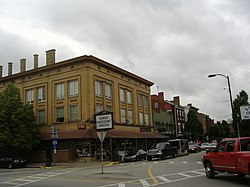Bardstown
| Bardstown, Kentucky | |
|---|---|
| City | |

Bardstown Historic District
|
|
| Nickname(s): Bourbon Capital of the World | |
 Location of Bardstown within Kentucky |
|
| Coordinates: 37°48′56″N 85°27′47″W / 37.81556°N 85.46306°WCoordinates: 37°48′56″N 85°27′47″W / 37.81556°N 85.46306°W | |
| Country | United States |
| State | Kentucky |
| County | Nelson |
| Settled | Salem, 1770s |
| Established | Bard's Town, 1780 |
| Incorporated | Bardstown, 1790 |
| Government | |
| • Mayor | J. Richard Heaton |
| Area | |
| • Total | 7.4 sq mi (19 km2) |
| • Land | 7.3 sq mi (19 km2) |
| • Water | 0.1 sq mi (0.3 km2) |
| Elevation | 646 ft (197 m) |
| Population (2010) | |
| • Total | 11,700 |
| • Density | 1,577.9/sq mi (609.2/km2) |
| Time zone | EST (UTC-5) |
| • Summer (DST) | EDT (UTC-4) |
| ZIP Code | 40004 |
| Area code(s) | 502 |
| FIPS code | 21-03628 |
| GNIS feature ID | 0486333 |
| Website | cityofbardstown.org |
Bardstown is a home rule-class city in Nelson County, Kentucky, in the United States. The population was recorded as 11,700 by the 2010 census. It is the county seat of Nelson County. It is named for the pioneering Bard brothers. David Bard obtained a 1,000 acres (400 ha) land grant in 1785 in what was then Jefferson County, Virginia from Governor Patrick Henry. William Bard surveyed and platted the town. It was originally chartered as Baird's Town.
First settled by European Americans in 1780, Bardstown is the second oldest city in Kentucky. Named county seat of the newly created Nelson County, Virginia (now Kentucky) in 1784, the town was formally established in 1788. It was incorporated by the state assembly in 1838.
Reflecting the westward migration of Americans over the "Blue Ridge" after the Revolutionary War, Bardstown was also the first center of Roman Catholicism west of the Appalachian Mountains in the original western frontier territories of the United States. The Diocese of Bardstown was established on February 8, 1808, by Pope Pius VII, (1742-1823, reigned 1800-1823), to serve all Catholics between the Appalachians and the Mississippi River. This divided the previous all-encompassing Diocese of Baltimore, established in 1789. This area is now served by 44 dioceses and archdioceses in 10 states, showing the development of communities with Catholics across the nation as immigration brought new populations.
...
Wikipedia
